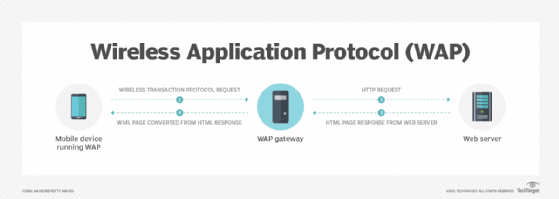Wireless Application Protocol (WAP)
What is Wireless Application Protocol (WAP)?
Wireless Application Protocol (WAP) is a specification for a set of communication protocols to standardize the way wireless devices, such as mobile phones and radio transceivers, can be used for internet access, including email, the web, newsgroups and instant messaging.
WAP was conceived in 1997 by Ericsson, Motorola, Nokia and Unwired Planet (now Enea Openwave Mobility) at an event known as the WAP Forum. While wireless internet access was possible before the introduction of WAP, different manufacturers used varying technologies, and WAP was intended to be an industry standard. However, WAP is now considered obsolete, as modern devices use networks and browsers that function similarly to those on PCs.
How does WAP work?
WAP describes a protocol suite designed to create interoperability between WAP equipment, such as mobile phones that use the protocol, and WAP software, such as WAP-enabled web browsers and network technologies. Before the introduction of WAP, mobile data access capabilities varied widely based on a user's device and mobile provider.
While the WAP protocol was created to standardize mobile data access, it was also a tool for overcoming the device- and carrier-related limitations that often resulted in mobile users having a bad experience. It did this in several ways:
- WAP supported existing and widely used internet standards such as Internet Protocol, User Datagram Packets and XML.
- The WAP protocol was optimized for the high-latency, low-bandwidth mobile networks of the time, which were notorious for dropping the connection before a page could fully render.
The Wireless Markup Language (WML) format allowed webpages to render without regard for a user's mobile hardware, much like Hypertext Markup Language (HTML) code can be rendered by any browser, regardless of what type of hardware the browser is running on.
Why use WAP?
Introduced in 1999, WAP proposed the following benefits for wireless network operators, content providers and end users:
- Wireless network and mobile phone operators. WAP was designed to improve existing wireless data services, such as voicemail, while enabling the development of additional new mobile applications. These applications could be developed without any further infrastructure changes or phone modifications.
- Content providers. WAP created a market for additional applications and mobile phone functionalities for third-party application developers to exploit. Writing applications in WML was proposed as a new programming language for developers to create effective mobile device applications.
- End users. Mobile phone users would benefit from easy, secure access to online services, such as banking, entertainment, messaging and other information, on mobile devices. WAP could also allow access to intranet information -- such as corporate databases and business applications.
Despite these proposed benefits, WAP did not experience widespread adoption in many countries, and its use declined significantly around 2010 due to widespread HTML compatibility in mobile phones.
WAP model
The WAP model works similarly to the traditional client-server model but depends on an additional component called a WAP gateway. This gateway's job is to act as an intermediary between mobile devices and the internet.
Mobile devices of the time lacked the hardware resources commonly found in today's devices. As such, devices were usually equipped with lightweight mobile browsers, also known as minibrowsers or microbrowsers. When a user entered a URL into their device's browser, the request was sent to a WAP gateway. This gateway would visit the site on the device's behalf, retrieve the requested page and then convert the page into WML format. That WML code would then be sent to the device that would render the page.

WAP protocol stack
The WAP standard describes the following protocol stack for interoperability of WAP devices, equipment, software and other technologies, which includes the following:
- Wireless Application Environment for mobile device specifications and programming languages such as WML;
- Wireless Session Protocol, which manages connection suspensions and reconnections;
- Wireless Transaction Protocol, which manages transaction support for requests and responses to servers;
- Wireless Transport Layer Security for managing privacy, authentication and data integrity through public key cryptography; and
- Wireless Datagram Protocol, an adaptation layer for consistent data formats in the other layers that defines how data flows to the sender from the receiver.
For more on Wireless Communications, read the following articles:
Wireless network capacity planning and requirements
Steps for wireless network planning and design
What is the difference between WLAN and Wi-Fi?
Advantages of WAP
The main benefit brought about by WAP was that it made broad internet access possible for mobile devices. Before adopting WAP, mobile carriers typically offered proprietary and extremely limited mobile access. A carrier might offer a few dedicated services providing stock quotes, movie listings, weather, news headlines and sports. However, general web access typically wasn't an option.
In addition to making broad internet access possible, WAP improved access speeds through data compression and helped reduce the number of timeouts and connection failures that had previously plagued mobile access.
Disadvantages of WAP
The primary disadvantage of WAP was that it was never universally adopted. In some areas, mobile providers held back adoption by charging significant additional fees for data access.
Another disadvantage to WAP was that mobile browsers of the time lacked the capabilities of modern browsers. As a result, WAP sometimes failed to render webpages on mobile devices correctly. Larger and more complex pages often couldn't be rendered at all.







